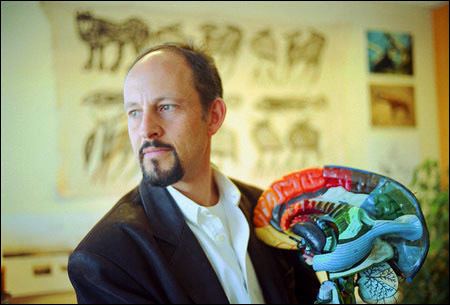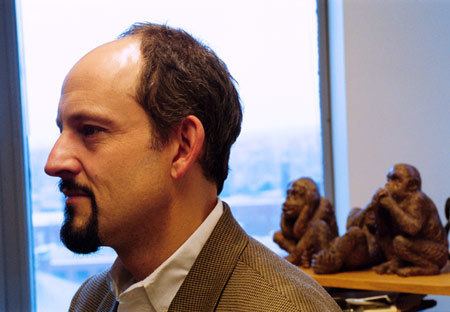Name Marc Hauser | Role Evolutionary Biologist | |
 | ||
Books Moral Minds, The Evolution of Communication, Wild Minds: What Animals Really Think, What Makes Us Evil?, Lucifer's Offer Education University of California, Los Angeles (1982–1987), Bucknell University Awards Guggenheim Fellowship for Natural Sciences, US & Canada | ||
Human morality marc hauser 1
Marc D. Hauser (born October 25, 1959) is an American evolutionary biologist and a researcher in primate behavior, animal cognition and human behavior. Hauser was a Harvard University professor from 1998 to 2011, regarded as "a leader in the field of animal and human cognition".
Contents
- Human morality marc hauser 1
- Human morality marc hauser 2
- Research and publications
- Books and essays
- Scientific misconduct
- Details retractions and replication
- Other controversy and allegations
- Related issues at Harvard
- Unreplicable cotton top tamarin study
- References

In 2010, Harvard found him guilty of scientific misconduct and a year later he resigned. Because his research was financed by government grants, the Office of Research Integrity of the Health and Human Services Department also investigated, reaching the same conclusion in 2012.

Human morality marc hauser 2
Research and publications

Hauser's research lies at the intersection of evolutionary biology and cognitive neuroscience. It was aimed at understanding the processes and consequences of cognitive evolution. His observations and experiments focused on nonhuman animals and humans of different ages and mental competence, incorporating methodology and theory from ethology, infant cognitive development, evolutionary theory, cognitive neuroscience and neurobiology. Research interests included: studies of language evolution, the nature of moral judgments, the development and evolution of mathematical representations, comparative studies of economic-like choice, the precursors to musical competence, and the nature of event perception.

His most widely known work involved long-term studies of monkeys and other primates. His lab at Harvard was called the "monkey lab". Another of his research projects was the internet-based 'The Moral Sense Test' in which the participant is presented with a series of hypothetical moral dilemmas and is asked to offer a judgment regarding each one.
Books and essays
Scientific misconduct
In 2007, Harvard University announced an internal investigation of alleged scientific misconduct by Hauser. In August 2010, the investigators found him solely responsible for eight counts of misconduct, and he took a year's leave of absence. In July 2011, Hauser resigned his faculty position at Harvard, effective August 1, 2011.
In his resignation, Hauser stated that he had "some exciting opportunities in the private sector" involving education for high-risk teenagers, but that he might go back to academia "in the years to come." As of May 2013, Hauser's LinkedIn profile listed him as a co-founder of the website Gamience, claiming "Scientifically-based games that address global health problems of self-control."
In September 2012, after conducting a separate investigation, the Office of Research Integrity (ORI) found Hauser guilty of scientific misconduct. They concluded that Hauser had fabricated data in one study, manipulated results in multiple experiments, and incorrectly described how studies were conducted. The ORI barred Hauser from certain types of research and required that other research be conducted under supervision. They published a notice stating:
Notice is hereby given that the Office of Research Integrity (ORI) has taken final action in the following case:
Marc Hauser, Ph.D., Harvard University: ORI found that Dr. Marc Hauser … engaged in research misconduct in research supported by
Details, retractions, and replication
The details of this investigation were not publicly released (which is common for most universities, including Harvard), and the lack of transparency evoked substantial speculation. Writing in the New York Times in August 2010, Nicholas Wade summarized:
There is a wide spectrum of scientific sins, ranging from wrist-slap offenses like bad data storage at one end, to data fabrication at the other. It is still not clear where on this spectrum Dr. Hauser's errors may fall. He has admitted only to unspecified "mistakes," not to misconduct.
On August 20, 2010, Michael Smith, Dean of Harvard's Faculty of Arts and Sciences, released a statement confirming that an internal investigation had found Hauser guilty of eight counts of scientific misconduct. Three counts involved published papers, and five involved unpublished studies. The statement said that Harvard was cooperating with further investigations by the US Office of Research Integrity, the National Science Foundation Office of Inspector General, and the U.S. Attorney for the District of Massachusetts. They stated that they would conduct their own review and make their conclusions available to the public.
A 2002 paper published in the journal Cognition was retracted. In this paper, Hauser and his collaborators concluded that cotton-top tamarin monkeys could learn simple rule-like patterns.
In two additional published papers, some field notes or video recordings were "incomplete", although Hauser and his co-author replicated the experiments. The Proceedings of the Royal Society published the replication of the missing data in an addendum to one of the papers. In April 2011 Hauser and Justin Wood (coauthor of the original paper) replicated the results of the 2007 Science study and published them—as an addendum—in the journal.
Charles Gross published an article in The Nation that detailed the Hauser case (Disgrace: On Marc Hauser. A case of scientific misconduct at Harvard).
Other controversy and allegations
In August 2010, after the initial allegations came out, various publications published other accusations and speculations about Hauser's research, often citing reports by his former students and research assistants.
Michael Tomasello, another well-known animal cognition researcher, claimed that some of Hauser's previous students personally told him that there "was a pattern and they had specific evidence". Tomasello also stated, prior to the official announcement, that he had information from "a Harvard faculty member and from former students of Dr. Hauser" that the investigation found evidence for eight counts of scientific misconduct; this statement was later confirmed by Harvard's dean (see previous section).
The Chronicle of Higher Education reported the contents of allegations made by a former research assistant of Hauser. The former research assistant stated that Hauser falsely coded videotapes of monkey behavior, resisted research assistants and students' requests to have them re-coded by another observer and pressured his students to accept his data analysis. When they re-coded the data without Hauser's permission, they allegedly found Hauser's coding bore little relation to what was on the tapes. According to the document, several other lab members had similar run-ins with Hauser.
An article in New Scientist claimed that Harvard opened its investigation of Hauser's lab after students who had worked there made allegations of data falsification.
Gerry Altmann, the editor of Cognition, subsequently posted his personal conclusion that Hauser fabricated data as part of a deception, after being given a summary of the relevant portions of Harvard's inquiry. Altmann noted that the conclusion of fabrication was his own conjecture, and not that of the Harvard investigation, which offered no explanation for discrepancies between the video record and the published paper.
Related issues at Harvard
While Harvard confirmed that misconduct was committed by Hauser, scientists continued to criticize Harvard over a lack of transparency in the investigation. However, Harvard stated that "in cases where the government concludes scientific misconduct occurred, the federal agency makes those findings publicly available."
Although Hauser took a year-long leave of absence from Harvard in 2010, he was at first still planning to teach at the Harvard Extension School, which generated further controversy. On September 1, 2010, his classes at the Extension School were canceled. In April 2011, he was barred from teaching in the Psychology department or any other Arts and Sciences department.
Unreplicable cotton-top tamarin study
In 1995, Hauser reported that cotton-top tamarins can recognize themselves in a mirror. Gordon G. Gallup questioned Hauser's findings, and reviewed some video recordings of Hauser's experiment, saying that "when I played the videotapes [for Hauser's experiments], there was not a thread of compelling evidence — scientific or otherwise — that any of the tamarins had learned to correctly decipher mirrored information about themselves. Upon requesting the remaining videotapes, Gallup was informed that the other tapes had been stolen. Together with Anderson, Gallup published a critical response to Hauser's article. Their criticism of Hauser's paper stated that the coding criteria were described in insufficient detail to code the monkeys' behavior and that, according to their assessment, the cotton-top tamarins did not show the behavior that they considered as evidence for mirror recognition in chimpanzees or other great apes.
Hauser and a co-author published a reply to these criticisms, clarifying their coding criteria. However, in 2001 Hauser reported that his subsequent attempts to replicate the experiments were unsuccessful, observing no evidence for the previously claimed result.
